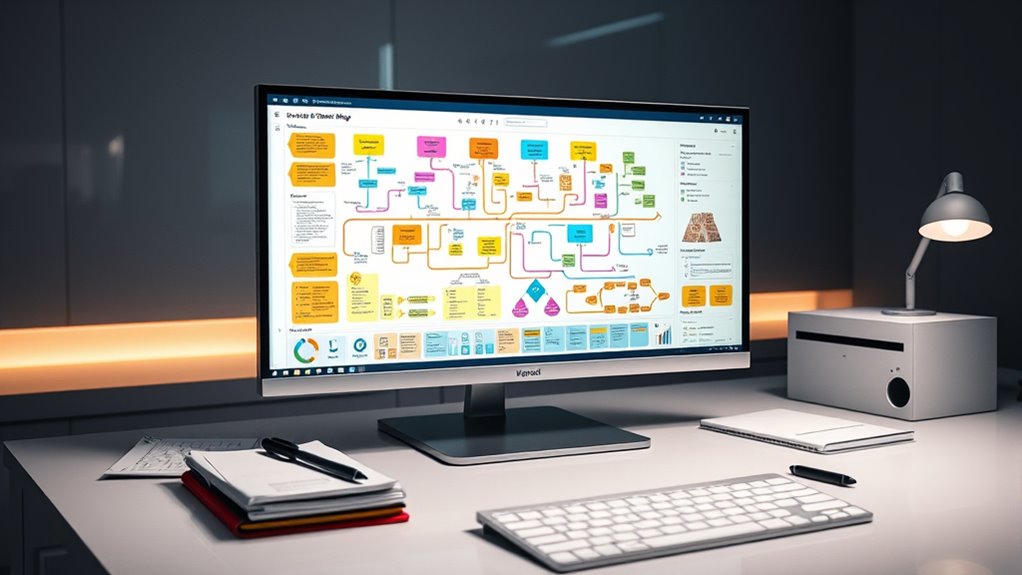Using value stream mapping for QA helps you quickly spot waste by visually analyzing every step from test planning to deployment. It reveals delays, redundancies, and bottlenecks, especially in automation processes. Collaborate with your team to uncover hidden issues and identify opportunities for process improvements. Small, targeted adjustments can be tested fast, boosting overall efficiency. Keep exploring how refining these workflows can lead to significant time savings and quality improvements.
Key Takeaways
- Visualize end-to-end QA workflows to quickly identify delays, redundancies, and waste points.
- Collaborate across teams to gain diverse insights and uncover hidden inefficiencies.
- Focus on automation bottlenecks to streamline testing processes and reduce cycle times.
- Use iterative mapping to continuously refine processes and eliminate waste efficiently.
- Enhance overall quality by aligning team efforts and visualizing areas for targeted improvements.

Have you ever wondered how to identify and eliminate waste in your QA processes? One effective way is through value stream mapping, a visual tool that helps you pinpoint inefficiencies quickly. When you start mapping out your QA workflow, you gain clarity on every step — from test planning to deployment — so you can see exactly where delays and redundancies occur. This process isn’t just about drawing boxes and arrows; it’s about actively analyzing your current state to identify opportunities for improvement.
One common obstacle you’ll encounter is automation bottlenecks. These are points in your testing pipeline where automation isn’t running seamlessly, causing unnecessary delays. Perhaps your automation scripts are slow to execute, or maybe manual interventions are needed at critical stages. When you map your value stream, these bottlenecks become glaringly obvious, giving you a clear target for optimization. Streamlining automation workflows reduces cycle times and frees up your team to focus on more complex testing tasks rather than fixing or re-running tests.
Automation bottlenecks highlight key areas to optimize, reducing delays and freeing your team for more complex testing tasks.
Another essential aspect of effective value stream mapping is fostering team collaboration. It’s tempting to isolate QA, development, and operations teams, but the truth is, collaboration accelerates waste elimination. When everyone shares insights during the mapping process, you uncover hidden issues and discover better ways to work together. For example, your developers might flag repetitive manual tasks or unclear requirements, while testers could point out gaps in automation coverage. By working together, your team can develop a shared understanding of the entire process, which leads to more targeted improvements. When team members communicate openly and understand each other’s roles, you reduce misalignments and redundant efforts that often contribute to waste.
Additionally, understanding the contrast ratio in your testing environments can help ensure your QA processes are accurately assessing visual outputs, which improves overall quality. Mapping your QA value stream in real-time encourages continuous improvement. As you identify waste, you can implement small changes, observe their impact, and adjust accordingly. This iterative approach ensures you’re always working towards a more efficient process. It also creates a culture of transparency and shared responsibility. When team members see tangible results from their collaborative efforts, morale improves, and everyone becomes more invested in maintaining optimized workflows.
Frequently Asked Questions
How Does VSM Integrate With Agile Development Processes?
You might wonder how VSM integrates with agile development processes. It enhances process integration by making workflows transparent and identifying waste quickly. As a team member, you collaborate more effectively because VSM highlights bottlenecks and areas for improvement. This promotes continuous feedback and iterative adjustments, aligning seamlessly with agile principles. By doing so, you streamline development, improve quality, and accelerate delivery cycles, ultimately making your team more efficient and responsive.
What Tools Are Best for Creating QA Value Stream Maps?
When creating QA value stream maps, you should focus on automation tools and visualization techniques. Automation tools like flowcharts and process mapping software help you quickly gather data and identify waste points. Visualization techniques, such as swimlane diagrams or digital dashboards, make it easier to see bottlenecks and inefficiencies. These tools enable you to develop clear, actionable maps that streamline your QA processes and improve overall efficiency effectively.
How Often Should a QA Team Update Their Value Stream Map?
While it’s wise to consider a regular cadence, your team should establish a flexible updating schedule based on project dynamics. For a frequency review, updating your value stream map every few sprints or after significant process changes ensures it remains relevant. By doing so, you keep waste identification sharp, fostering continuous improvement. Remember, adapting your update frequency to your workflow helps maintain clarity without overburdening your team.
Can VSM Identify Root Causes of QA Bottlenecks?
Yes, VSM can help you identify root causes of QA bottlenecks by revealing process inefficiencies. It visualizes each step, so you see where delays or redundancies occur. This promotes team collaboration, enabling everyone to analyze and discuss issues openly. By pinpointing specific process flaws, you can target improvements effectively, reducing bottlenecks and enhancing overall QA performance efficiently.
What Are Common Challenges When Implementing VSM in QA?
Imagine trying to steer a ship through turbulent waters—you need clear directions, but cultural resistance can make your crew hesitant to change. When implementing VSM in QA, you face challenges like cultural resistance and data accuracy issues. These obstacles slow progress, like fog clouding your vision. Overcoming them requires patience, open communication, and reliable data. Only then can you navigate toward streamlined processes and better quality outcomes.
Conclusion
By mastering value stream mapping for QA, you illuminate hidden waste like a lighthouse in fog, guiding your team toward efficiency. With just minutes, you can identify bottlenecks and streamline your processes, turning chaos into clarity. Embrace this powerful tool to transform your QA workflow from a tangled web into a well-oiled machine. When waste is spotted and removed swiftly, your quality assurance becomes not just a step, but a strategic advantage in your project’s success.









